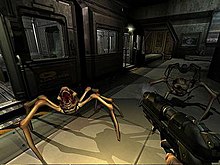
Back Schatten (Computergrafik) German Carmack's Reverse French Schaduwvolume Dutch Carmack’s Reverse Polish Просторне сенке Serbian 阴影体 Chinese
This article needs additional citations for verification. (July 2024) |

Shadow volume is a technique used in 3D computer graphics to add shadows to a rendered scene. It was first proposed by Frank Crow in 1977[1] as the geometry describing the 3D shape of the region occluded from a light source. A shadow volume divides the virtual world in two: areas that are in shadow and areas that are not.
The stencil buffer implementation of shadow volumes is generally considered among the most practical general purpose real-time shadowing techniques for use on modern 3D graphics hardware[citation needed]. It has been popularized by the video game Doom 3, and a particular variation of the technique used in this game has become known as Carmack's Reverse.
Shadow volumes have become a popular tool for real-time shadowing, alongside the more venerable shadow mapping. The main advantage of shadow volumes is that they are accurate to the pixel (though many implementations have a minor self-shadowing problem along the silhouette edge, see construction below), whereas the accuracy of a shadow map depends on the texture memory allotted to it as well as the angle at which the shadows are cast (at some angles, the accuracy of a shadow map unavoidably suffers). However, the technique requires the creation of shadow geometry, which can be CPU intensive (depending on the implementation). The advantage of shadow mapping is that it is often faster, because shadow volume polygons are often very large in terms of screen space and require a lot of fill time (especially for convex objects), whereas shadow maps do not have this limitation.
- ^ Crow, Franklin C: "Shadow Algorithms for Computer Graphics", Computer Graphics (SIGGRAPH '77 Proceedings), vol. 11, no. 2, 242–248.